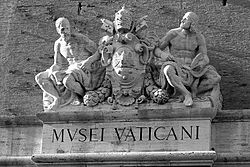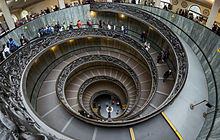| Vatican Museums | |
|---|---|
| Musei Vaticani | |
 | |
| Established | 1506 |
| Location | Vatican City |
| Visitors | 4,310,083 (2008) |
| Director | Antonio Paolucci |
| Website | http://www.museivaticani.va |
The Vatican Museums (Musei Vaticani), located inside the Vatican, are among the greatest museums in the world, since they display works from the immense collection built up by the Roman Church throughout the centuries including some of the most renowned classical statues and most important masterpieces of Renaissance art in the world.
Pope Julius II founded the museums in the early 16th century.
The Sistine Chapel with its ceiling decorated by Michelangelo and the Stanze della Segnatura decorated by Raphael are on the visitor route through the Vatican Museums.
They were visited by 4,310,083 people in the year 2007.[1]
The Vatican Museums broke attendance records in 2011 with just over 5 million people.
The Vatican Museums trace their origin to one marble sculpture, purchased 500 years ago.
The sculpture of Laocoön and his Sons was discovered 14 January 1506, in a vineyard near the basilica of Santa Maria Maggiore in Rome.
Pope Julius II sent Giuliano da Sangallo and Michelangelo Buonarroti, who were working at the Vatican, to examine the discovery.
On their recommendation, the pope immediately purchased the sculpture from the vineyard owner.
The pope put the sculpture of Laocoön and his sons on public display at the Vatican exactly one month after its discovery.
The Museum Christianum was founded by Benedict XIV, and some of the Vatican collections formed the Lateran Museum, which Pius IX founded by decree in 1854.
The Museums celebrated their 500th anniversary in October 2006 by permanently opening the excavations of a Vatican Hill necropolis to the public.[3]
The art gallery -- Pinacoteca Vaticana -- was housed in the Borgia Apartment, until Pope Pius XI ordered construction of a proper building.
The new building was inaugurated on October 27, 1932.
The designer was Luca Beltrami.
The museum has paintings including:
[
The Collection of Modern Religious Art houses paintings and sculptures from artists like Carlo Carrà and Giorgio de Chirico.The group of museums includes several sculpture museums surrounding the Cortile del Belvedere.
[edit] Museo Pio-Clementino
Pope Clement XIV founded the Pio-Clementino museum in 1771.
Originally it contained the Renaissance and antique works.
The museum and collection were enlarged by Clement's successor Pius VI.
Today, the museum houses works of Greek and Roman sculpture.
There are 54 galleries, or salas, in total, with the Sistine Chapel, notably, being the very last sala within the Museum – visitors need to proceed through the other 53 salas before earning their reward with access to the Sistine.
Some notable galleries are:
It also contains the Barberini Candelabra.
This museum CHIARAMONTI is named after Pope Pius VII (whose last name was Chiaramonti), who founded it in the early 19th century.
The museum consists of a large arched gallery in which sides are exhibited several statues, sarcophaguses and friezes.
The New Wing, Braccio Nuovo built by Raphael Stern, houses important statues like The Prima Porta Augustus, Doryphorus, and The River Nile.
Galeria Lapidaria is another part of Chiaramonti museum, with more than 3,000 stone tablets and inscriptions, which is the world's greatest collection of its kind. However, it is opened only by special permission, usually for reasons of study.
The "MUSEO GREGORIANO ETRUSCO" was founded by Pope Gregory XVI in 1836.
The museum has eight galleries and houses important Etruscan pieces, coming from archaeological excavations.[5] The pieces include: vases, sarcophagus, bronzes and the Guglielmi Collection.
The "MUSEO GREGORIANO EGIZIANO" was founded by Pope Gregory XVI in 1839.
This museum houses a grand collection of Ancient Egyptian material.[6] Such material includes papyruses, the Grassi Collection, animal mummies, and reproductions of the famous Book of the Dead.[7]
[edit] Works in the Vatican museums
- The red marble papal throne, formerly in the Basilica di San Giovanni in Laterano;
- Roman sculpture, tombstones, and inscriptions, including the Early Christian Sarcophagus of Junius Bassus and Dogmatic sarcophagus, and the epitaph of Lucius Cornelius Scipio Barbatus;
- The Raphael Rooms with many works by Raphael and his workshop, including the masterpiece The School of Athens
- Other Raphael masterpieces including "The Transfiguration".
- The Niccoline Chapel
- The Sistine Chapel
- The Gallery of Maps: topographical maps of the whole of Italy, painted on the walls by friar Ignazio Danti of Perugia, commissioned by Pope Gregory XIII (1572–1585). It remains the world's largest pictorial geographical study.
- The frescoes and other works in the Borgia Apartment built for Pope Alexander VI (Borgia).
On the last Sunday of each month, the Vatican Museum is open to the public for free. This is extremely popular and it is common for people to wait in line for many hours. The other days of the week you can use the online ticket office to purchase an individual ticket or group tour ticket, either of which will enable you to bypass the ticket line completely. This image is a panoramic view of one small stretch of the entire queue in April 2007, which continues for some distance in both directions beyond view.
[
Usually more than 4 million people visit the Museums every year. In 2011, the number of visitors reached 5 million. (by Editor Report Antonio Paolucci in "L'Osservatore Romano" of January 10, 2012)[edit] See also
[edit] References
- ^ a b "Dossier Musei 2008 – Touring Club Italiano". http://www.touring.it/Pdf/dossier/Musei2008.pdf.
- ^
 "Christian Museums". Catholic Encyclopedia. New York: Robert Appleton Company. 1913.
"Christian Museums". Catholic Encyclopedia. New York: Robert Appleton Company. 1913. - ^ Guardian.co.uk
- ^ [1]
- ^ [2]
- ^ [3]
- ^ [4]
[edit] Further reading
- G. Spinola, Il Museo Pio-Clementino (3 vols., 1996, 1999, 2004)
- G. B. Visconti and E. Q. Visconti, Il Museo Pio-Clementino Descritto (8 vols., 1782-1792)
[edit] External links
| Wikimedia Commons has media related to: Museums in the Vatican City |
- Vatican Museums official website
- Vatican Museums official on-line ticket office
- Official English information
| ||
| |||
Categories:
- Museums in Vatican City
- 1506 establishments
- Art museums and galleries in Rome
- Art museums established in 1506
- Buildings and structures in Vatican City
- Egyptological collections in Italy
- Museums of Ancient Greece
- Museums of Ancient Rome
- Museums of Dacia
- National museums
- Organizations established in the 1500s
- Religious museums in Italy
- Vatican City culture














No comments:
Post a Comment